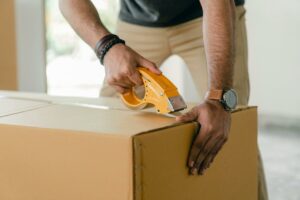August 8, 2024
The Do’s and Don’ts of Moving Plants

Whether you’re moving across the country or the state, moving is a hard job, to say the least. Add the added pressure of moving safely with plants, and you’ve got quite the challenge ahead of you. But moving with your plants doesn’t have to be hard. With the right tips and tricks, moving plants can be a breeze.
Check out our helpful guide on how to move plants safely and simplify your next move!
Preparing Your Plants for the Move
Before packing up your plants, there are some things you should do first to ensure the transition goes as smoothly as possible.
- Trim: To make moving your plants easier, trimming any dead or excess branches, leaves, or foliage can be helpful.
- Check for Pests: Before packing up your plants, make sure to check for pests on your plants.
- Check Regulations: Different states have different regulations regarding plants. So, before moving plants, check the regulations regarding transporting plants to the state you’re moving to.
- Re-pot: If your plants are in ceramic planters, consider transferring them to plastic pots to reduce their weight and the chance of breakage during the move.
- Water: Watering your plants in advance can help prevent them from dying or drying out during the move. It is best to water them a few days before the move.
- Dig Up Outdoor Plants: To dig up outdoor plants, you’ll want to remove the plant and its roots. Try to keep the roots as intact as possible. Then, place the plant in a new container or a plastic bag to ensure the roots don’t dry out.
How to Transport Plants Efficiently
To help your moving day go as smoothly as possible, here are some tips to follow when transporting your plants.
- Gather Useful Supplies: The right supplies can make the process much easier. When moving plants, you’ll want to have durable boxes in various sizes, bubble wrap, packing paper, and paper bags.
- Packing Small Plants: For smaller plants, cover the foliage and base with plastic bags to help protect them from damage. Small plants should be placed in a bubble wrap-lined box and placed so that they are snug but not too crowded. To help fill extra gaps in the box, use packing paper to avoid movement.
- Packing Tall Plants: Tall plants should be packed standing directly on the floor. Placing a plastic bag around the base of the plant can also help prevent dripping water or soil from spilling. Put other items around the plants to ensure they don’t fall over during the move.
- Packing Leafy Plants: Cover leafy plants’ foliage with plastic bags to reduce the likelihood of damage.
- Temperature: During your move, avoid exposing your plants to extreme temperatures. It is vital to keep them away from any heaters or air conditioners. If possible, transport your plants in your vehicle, an environment where you can control the temperature.
- Using Movers: If you’re using movers, be sure to label each box clearly so they know which ones contain plants. This will help ensure the movers carefully handle these boxes and avoid accidentally crushing the plants.
- Shipping Plants: When shipping your plants, remove them from their pots and wrap their roots in a wet paper towel covered with plastic. Make sure to pack the plants snuggly into a sturdy box.
What to Avoid When Moving Plants
To ensure your plants survive moving day, some things are crucial to avoid. Here are some key things to steer clear of.
- Overwatering or Underwatering: Overwatering your plants before moving will not only make the move messy, but it can also cause root rot. In contrast, underwatering your plants will cause them to dry out, resulting in them possibly dying during the move.
- Bad Handling: To avoid damaging your plants, handle them carefully when packing and unpacking them.
- Not Labeling: Marking your boxes during your move is essential in preventing damage to your plants. Don’t forget to label your plant boxes as fragile!
- Inadequate Packing: Packing your plants without the necessary protection can cause them to tip over, spill, or become damaged during the move, so skip the flimsy boxes.
Unpacking Your Plants
Moving plants can be stressful for them, especially if you’re moving plants cross-country. When arriving at your new home, unpack your plants from their boxes, remove the plastic from them immediately, and water them. If you removed any plants from their original planters, wait a week before putting them back to avoid stressing the plants too much. For garden plants, you’ll want to replant them as soon as possible.
Need Help Moving Plants?
Moving can be a stressful experience. At Good Stuff Moving, we make it our mission to make your next move stress-free and simple. Our team of professionals understand that plants require delicate and expert handling during moves. You can trust us to get the job done safely and effectively. Choose between our 5-helpful options to help your move go exactly to plan.
If you’re ready to learn more about our services and how we can make your move easier, request a free quote today!




